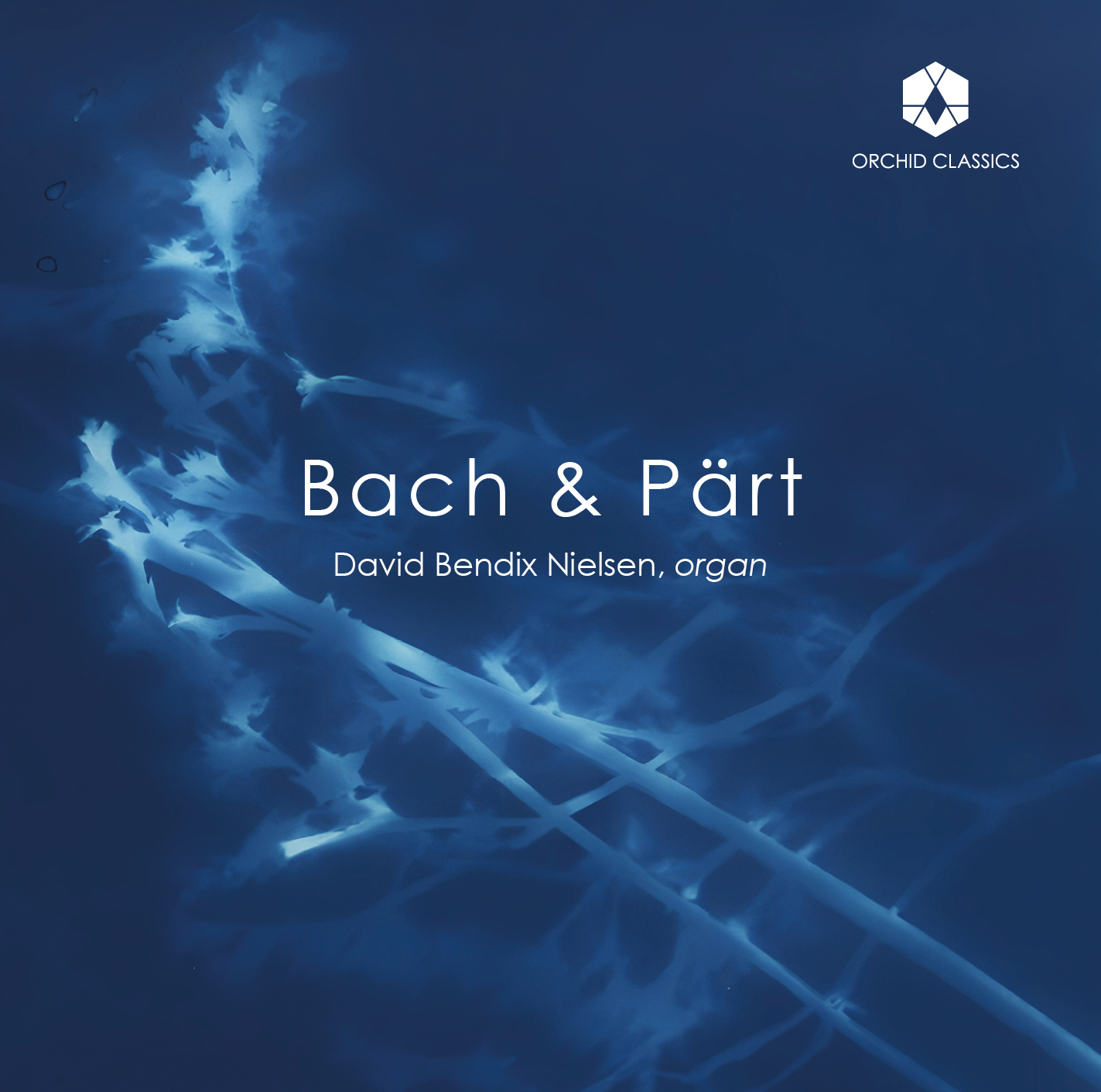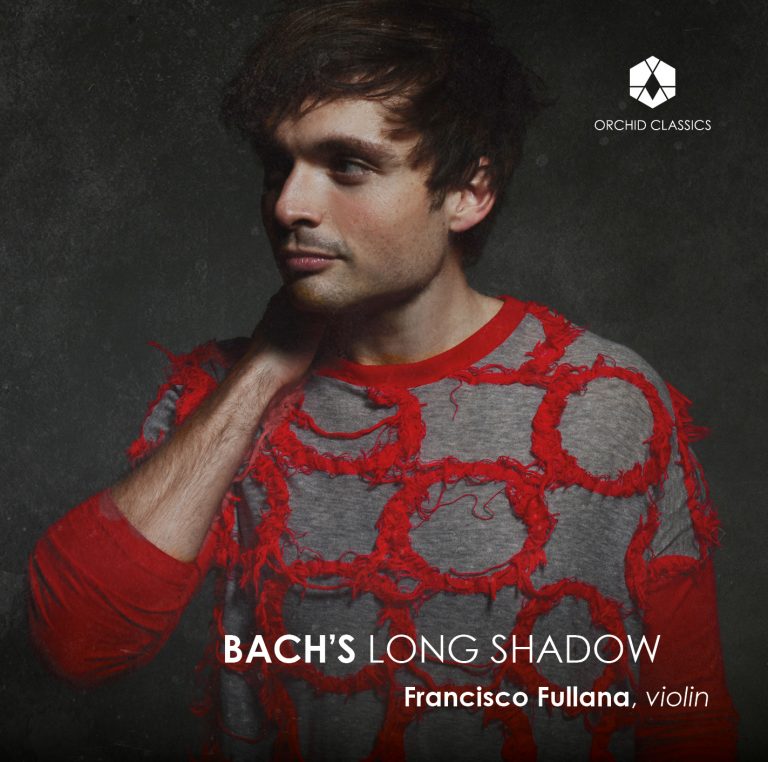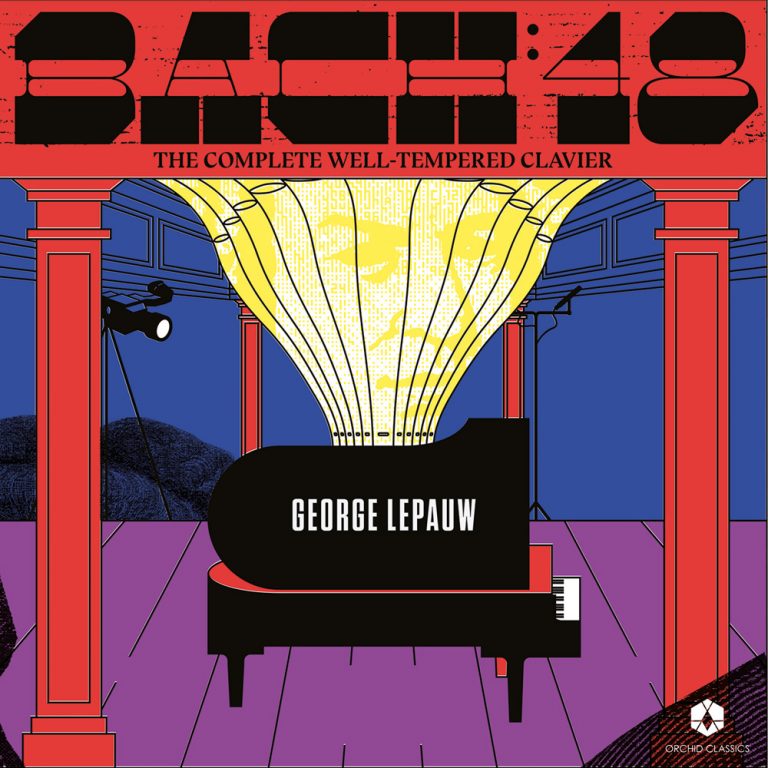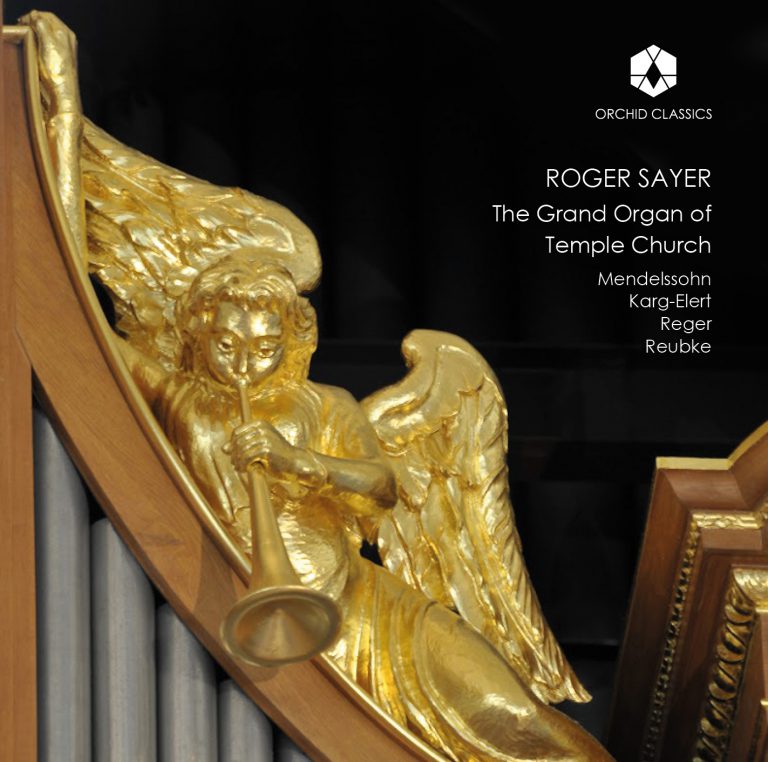Artist Led, Creatively Driven

Bach & Pärt
David Bendix Nielsen
Organ
Release Date: 24 June
ORC100197
BACH & PÄRT
Johann Sebastian Bach (1685-1750)
Prelude and Fugue in E-flat major “St. Anne”, BWV 552
1. Prelude
2. Fugue
Arvo Pärt (b.1935)
3. Pari intervallo
Johann Sebastian Bach
Concerto in D minor after Antonio Vivaldi, BWV 596
4. I Allegro
5. II Largo e spiccato
6. III Allegro
Arvo Pärt
7. Trivium
Johann Sebastian Bach
8. An Wasserflüssen Babylon, BWV 653
9. Trio super “Herr Jesu Christ dich zu uns wend”, BWV 655
10. Allein Gott in der Höh sei Ehr, BWV 662
Arvo Pärt
11. Spiegel im Spiegel
Johann Sebastian Bach
Passacaglia and Fugue in C minor, BWV 582
12. Passacaglia
13. Fugue
David Bendix Nielsen, organ
The Master and the Minimalist
The pieces on this album were selected so as to create a coherent narrative, and simultaneously to highlight important works from the composers’ catalogue.
When I prepare my concert programmes, I always aim to offer the audience an organic narrative that presents the instrument’s many nuances and leads them through the concert as if it were a story told, with ups and downs, highs and lows, powerful outbursts, and meditative moments. With this approach in mind I have put together the album’s repertoire, where Arvo Pärt’s minimalistic and meditative pieces create contrast to Bach’s intellectual compositions, powerful settings, and beautiful chorales.
The pieces are also connected by tonality: Bach’s Prelude and Fugue in E-flat major – Pärt’s Pari Intervallo in E-flat minor; Concerto in D minor – Trivium in D minor; Spiegel im Spiegel in C major – Passacaglia and Fugue in C minor. The two big pieces at the very beginning and the end encapsulate the album’s more delicate parts.
The music on the album is at the core of my concert repertoire and is some of the most beautiful organ music written by Bach and Pärt, respectively.
The Garrison Church & the organ
Completed in 1706 as a church for the army garrison in Copenhagen, the Garrison Church was built by Frederik IV, whose monogram is seen above the west door on the altarpiece and at the top of the towers of the organ case. Very soon, after the completion of the church, it was used by the citizens of the newly built Frederik’s Town, and from 1804 as a civilian church as well.
The Garrison Church got its first large organ in 1724. It was built by Lambert Daniel Kastens in Itzehohe and transported to Copenhagen by sea. The instrument was built in the North German baroque tradition, which is known from Kastens’ teacher, Arp Schnitger’s extensive production. The organ was later rebuilt and renewed, but in 1995 a new organ was inaugurated, built by the Danish organ builder Carsten Lund.
A large donation from the Velux Foundation formed the financial basis for this project, for which the organ was prepared by the organ builder and his staff together with organ consultant Per Kynne Frandsen, the Dutch organologist Dr. Cornelius Edskes and organist Hans Westenholz.
The disposition and structure of the original baroque organ forms the basis of the current instrument, with 45 registers, a total of 2861 pipes that are divided into 4 works – Rückpositiv, Hauptwerk, Brustwerk and Pedal. Centrally located under the clock is the main work (Hauptwerk) and below is the Brustwerk. These are flanked by the two pedal towers, which are crowned with Frederik IV’s monogram, and which contain the voices the organist plays with his feet on the pedal keyboard. Closest to the congregation is the back positive (Rückpositiv) – a smaller version of the main work, recessed in the balustrade on the organ pulpit. Queen Margrethe II’s monogram is seen above the middle of the main organ.
The organ is tuned in a historical temperament that favours certain keys and its tonal range is slightly smaller than that of a modern organ. In addition to its primary liturgical use, the instrument is extremely suitable for reproduction of German and Dutch baroque music. It is very popular with both domestic and foreign artists for concerts and recordings. Concert series with Bach and Buxtehude’s combined organ works have been carried out with the organ professors Bine Bryndorf and Hans Fagius from the Royal Danish Music Conservatory as soloists.
Among the church’s former musicians in the 19th century, the composers J. P. E. Hartmann and his son-in-law Niels W. Gade should be highlighted; both held the office of organist for a number of years in their younger days.
David Bendix Nielsen
The organ played a vital role in every stage of J.S. Bach’s life. As a young man in 1706, Bach famously walked 280 miles to Lübeck see Buxtehude playing the organ. One of his sons, C.P.E. Bach, wrote in Bach’s obituary: “At a certain moment here in Arnstadt he had so strong an urge to hear as many good organists as he could that he set out for Lübeck, on foot, in order to hear the famous organist of St Mary’s, Dietrich Buxtehude.”
Later, in the prestigious role of cantor at the Thomasschule in Leipzig from 1723, Bach’s duties were wide-ranging, including playing organ preludes at regular intervals throughout the four-hour-long Lutheran services, preceding chorales and larger choral works. The music that might have been played before and after the services was less formally outlined, and may have extended to preludes and fugues, which built on the precedents of his toccatas and fugues, although it seems unlikely that Bach would have indulged in anything as showy as these works before or after a church service. In 1705, while temporarily in Leipzig, he had been censured for an over-long organ prelude before Communion, and in 1706 he had attracted the ire of the Arnstadt authorities by confusing the congregation with complicated chorale accompaniments.
Among Bach’s most significant volumes of keyboard works were the series of Clavier-Übung (Keyboard Exercise) publications, a title inherited from Bach’s Leipzig predecessor, Johann Kuhnau. Part III was devoted to music for the organ, amounting to what is sometimes called the ‘German Organ Mass’ – probably Bach’s most significant organ work. This was Bach’s equivalent of the Livres d’orgues by composers such as Nicolas de Grigny and Pierre Du Mage; French models that influenced his inclusion of free pieces, such as preludes, fugues and duets, and chorale settings of the Kyrie and Gloria as well as Lutheran hymns. The volume shows Bach broadening his stylistic range from traditionally ecclesiastical styles to more up-to-date idioms. In 1740 Lorenz Christoph Mizler reviewed the result: “The author has here given new proof that in this field of composition he is more practised and more fortunate than many others. No one will surpass him in it, and few will be able to imitate him”, adding that “this work is a powerful refutation of those who have made bold to criticise the composition of the Honourable Court Composer”.
The first piece of the Clavier-Übung III is the Prelude in E-flat major, BWV 552/1; the last piece is the Fugue in E-flat, BWV 552/II. Along with BWV 540, the Prelude is the longest of Bach’s organ preludes, and combines elements of the French overture, Italian concerto and German counterpoint. By beginning and ending the Clavier-Übung III with these pieces, Bach may have been conveying a spiritual message: the all-embracing nature of the Trinity. The Prelude has three themes considered to represent God the Father, Son and Holy Spirit, and even the three flats of the key signature may be symbolic. In the same key, the Fugue picks up this symbolism with a ‘triple fugue’ in which the theme is woven into three distinct fugal patterns. The theme resembles the ‘St Anne’ hymn tune by William Croft, possibly unknown to Bach but earning these pieces the nickname ‘St Anne’.
Bach’s obituary says that “he wrote most of his organ works” during his second period at the Weimar court (1708-17), and it seems likely that the concertos BWV 592-596 originated during this time. The manuscript paper used for the Concerto in D minor, BWV 596, corresponds with that used by Bach in his cantatas of 1714-15. Bach transcribed numerous Vivaldi concertos, as his first biographer, Johann Nikolaus Forkel, described: “Vivaldi’s violin concertos, just then being published, gave [Bach] the guidance he needed. He so often heard them cited as outstanding compositions that he thereby hit upon the happy idea of transcribing them as a group for the keyboard. Hence, he studied the progression of the ideas and their relations, variety in modulating and many other things”.
BWV 596 is a transcription of Vivaldi’s Concerto in D minor for two violins and obligato violoncello, Op.3, No.11, RV 565. In the opening movement, Bach articulates Vivaldi’s contrasts between soloists and ensemble by distributing the material between the two manuals, before unfolding a fugue that sounds smoother and less delineated on the organ. The siciliano second movement is characterised by simple chords supporting a sweet melody, and the opening theme of the third movement was also used by Bach in his cantata BWV 21 (1714), Ich hatte viel Bekümmernis (‘I had much grief’).
Bach’s Great Eighteen Chorale Preludes, BWV 651-668, sometimes called the ‘Leipzig Chorales’, were finished in Leipzig some time during 1740-1750, probably 1747-48, based on earlier music composed in Weimar. Along with the Clavier-Übung Part III they are among Bach’s most significant organ works. The contemplative An Wasserflüssen Babylon (‘By the waters of Babylon’), No.3, BWV 653, is a sarabande based on a hymn tune, the words of which stem from Psalm 137. In contrast, the ‘Trio super’ Herr Jesu Christ dich zu uns wend (‘Lord Jesu Christ, turn to us’), No.5, BWV 655, has the texture of a trio sonata and evokes a joyful text with music reminiscent of Vivaldi. Based on a German hymn, Allein Gott in der Höh’ sei Ehr (‘Alone to God on high be honour’), No.12, BWV 662, is remarkable for its Adagio marking and ornate textures, with two fugal inner parts supported by a continuo-like bass line and decorated by a ‘cantus firmus’.
Bach regularly tested organs; C.P.E. Bach recorded that this involved assessing the instrument’s “lungs”: “To find out, he would draw out every speaking stop, and play in the richest possible texture. At this the organ builders would often grow quite pale with fright.” The stunning Passacaglia and Fugue BWV 582 are “in the richest possible texture” and date from between 1706 and 1713, possibly when Bach was at Arnstadt after returning from Lübeck. A passacaglia, like a chaconne, is structured around a recurring line: in a chaconne this is restricted to the bass, but in a passacaglia the recurring theme may be used in the upper voices. The Passacaglia BWV 582 opens with the solemn theme played on the pedals before numerous variations unfold. A double Fugue follows: the first half of the Passacaglia theme is used as the basis of the first subject, and a transformed version of the theme’s second half is used as the second subject; Bach deftly weaves a countersubject into the mix to create a precision-engineered texture.
Estonian composer Arvo Pärt’s output has evolved dramatically over the course of his life. By the 1960s, he had embraced serialism; he then toyed with collage techniques before withdrawing to study plainchant, Renaissance music and the music of the Russian Orthodox Church. Pärt emerged from this process in the 1970s with a style he called ‘tintinnabuli’, from the Latin meaning ‘bell’. Of this technique, Pärt has said: “Tintinnabulation is an area I sometimes wander into when I am searching for answers… In my dark hours, I have the certain feeling that everything outside this one thing has no meaning. The complex and many-faceted only confuses me, and I must search for unity.” He explained: “… one note … or a moment of silence, comforts me. I work with very few elements – with one voice, with two voices. I build with primitive materials – with the triad, with one specific tonality. The three notes of a triad are like bells. And that is why I call it tintinnabulation.”
Pari intervallo was originally written for four unspecified parts in 1976 but was arranged for specific instruments thereafter, including organ in 1980. The work was composed as a memorial to the composer’s stepfather and is prefaced by a quote from St Paul to the Romans: “For whether we live, we live unto the Lord; and whether we die, we die unto the Lord.” The title is Latin for “in the equal distance” and the music reflects this, built on two parallel voices that remain the same interval apart throughout.
Trivium (1976) is one of the first of Pärt’s tintinnabular pieces and was performed at the concert at which he introduced this concept to the world, on 27 October 1976 in the Estonia Concert Hall, Tallinn. Trivium is the only piece on the programme that has remained unchanged since. The Latin title means three paths that head in the same direction: towards the Truth. Three short sections use the same ideas varied in accordance with the tintinnabular technique. The title Spiegel im Spiegel (1978) can mean ‘Mirror in the mirror’ or ‘Mirrors in the mirror’, referring to an infinity mirror; the tintinnabular style creates a hypnotic effect as the repeated triads are ‘mirrored’ with small variations. The piece is one of only a handful of contemporary pieces that has achieved international fame beyond the world of classical music, countless listeners touched by the piece’s affecting simplicity and sincerity.
© Joanna Wyld, 2022
David Bendix Nielsen
David Bendix Nielsen (b.1993) is a Danish/Hungarian organist based in Copenhagen. He was educated at the Royal Danish Academy of Music and the Hochschule für Musik und Theater Hamburg with Professor Bine Bryndorf, Hans Fagius and Wolfgang Zerer.
David was born in Denmark, but raised in Hungary, where he received his primary musical education. He started his organ studies at age 14, when he was finally able to reach the pedals, at the music high school in Győr. Four years later, he was accepted at the Music Academy in Copenhagen. David has further educated himself in masterclasses with artists such as Olivier Latry and Hans-Ola Ericsson, and competed in international organ competitions, the latest being the Nordic Organ Competition 2021 in Stavanger, where he won 2nd prize. In 2018 he was a recipient of the prestigious Léonie Sonning Talent Prize, and from 2022 to 2023 David is chosen as a recipient of the Young Cultural Elite scholarship from the Danish Arts Foundation.
Despite his young age, David already has an impressive series of concerts behind him, both in Denmark and abroad. He has performed at international organ festivals such as the Ivan Sokol Festival in Slovakia, the Antiqua Vox Festival in Italy and the Ars Sacra Festival in Hungary. He has played solo recitals at venues such as Temple Church and Westminster Abbey in London, Lund Cathedral in Sweden and Basilique Sainte-Clotilde in Paris. He is also active in projects with ensembles and choirs, most notably the vocal group Theater of Voices and the Danish National Symphony Orchestra.
David is the organist of St. Mark’s Church in Copenhagen and has previously held positions in some of the most important churches in Denmark; Roskilde Cathedral with its world renowned historic Raphaëlis Organ from the 16th century, as well as Holmens Church, the church of the Royal Navy. Besides his career as a performer, he is teaching at the Royal Danish Academy of Music.









